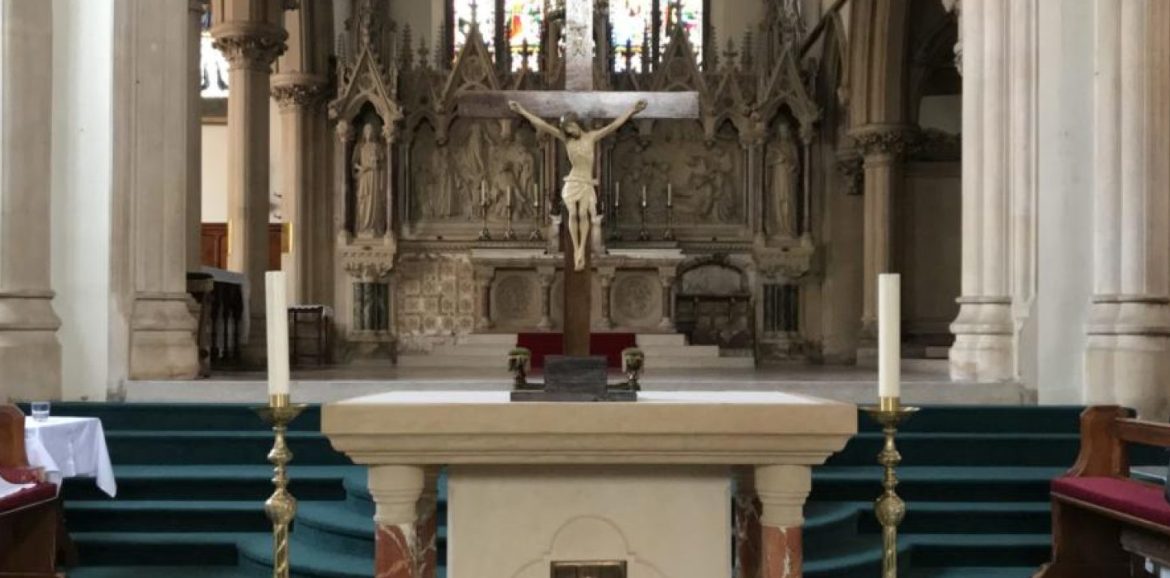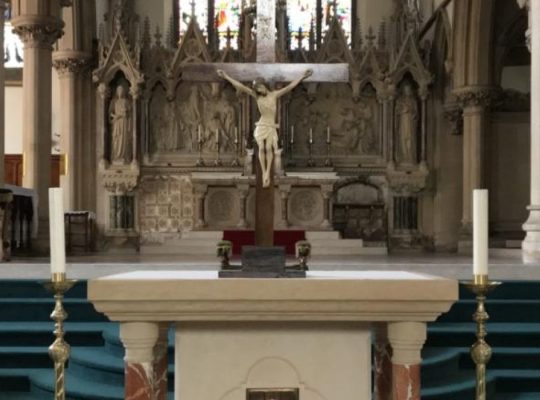“Having died on the cross, Jesus rose on the third day.” Such is the Easter message untiringly proclaimed by the apostles and, after them, the Church; such is the faith constantly reaffirmed by all Christians when they say the Creed. For many centuries, unbelievers spoke of it with the indifference and cold objectivity of Feasts, the Procurator of Judea (from 52 to ca 60): “The Christians claim, that a certain Jesus, who died and is alive.” Whatever one thinks of this faith, there seems to be nothing subversive about it today. As for the Christians themselves, a not unlikely result of saying the Apostles Creed and hearing their testimony is the dulling of their attention. It might even be totally relaxed during the season of Easter when they hear successive announcements of the resurrection that all say the same thing: “Christ is risen.” But shouldn’t the Sundays of Easter all vie in proclaiming this? The regular reprise of the paschal message and the proclamation of the mystery celebrated during these fifty days help make them penetrate deeply into us and strengthen our faith. The reminder of the various circumstances in which the apostles gave their testimony is a stimulating example: all occasions are appropriate for announcing the Lord’s resurrection; the duty to do so cannot be shirked. Finally, one must acknowledge that since the beginning, the presentation of the same news has taken various forms, which lead to later catechesis. Thus today we have Peter’s discourse at his first arraignment before the Sanhedrin.
Peter and John are asked about the lame man who begged at “the Beautiful Gate” of the Temple: “By what power or by what name have you done this?” Peter makes a declaration that responds to the question but is aimed at a larger audience than the members of the council: “You and all the people of Israel should know……” Peter speaks with such force, assurance, and concern with being heard far and near because he is “filled with the Holy Spirit,” the Spirit of Pentecost who carries the voices of the Gospel’s preachers everywhere.
It was done “in the name of Jesus Christ the Nazarene whom you crucified, whom God raised from the dead.” The “name” of Jesus, i.e., his person, saves whoever invokes it because God, by raising him, has made Jesus Lord.
He is the “stone rejected by you, the builders, which has become the cornerstone.” This is not just a forceful and often quoted scriptural image. The Psalm we hear today has a messianic meaning. It was used in this way in the Temple liturgy; it may even have been composed for it. One of the six Psalms of the so-called Hallel collection most famous for being sung during the Passover meal, it was used by Jesus at the Last Supper. Verse 22 is cited in the parable of the murderous vineyard workers, which is an announcement of the passion and resurrection of Christ, the Son sent by God. (Luke 20: 15-18) In addition, Acts and the First letter of Peter interpret it as applying to Christ.
Such use indicates the need to reread the Scriptures that witness to Christ and help us to better understand his paschal mystery. The Christian cannot neglect this duty by merely running through the Old Testament every now and then, looking for apologetic material, as though that’s all the Book of Promise is good for. The way the Church and many Christians each day make use of the Psalms in the daily office is an exemplary guide. This collection of one hundred and fifty inspired poems presents a palette of almost all the literary genres of the Bible. Especially notable are the “historical “ psalms. In the events of the past, especially the most significant of them—creation, Exodus, etc.—the inspired poet recognises God’s initiative and action, the manifestation of his sovereign strength, his fidelity. Such meditation casts light on the present when the believer is confronted with questions and doubts, joys and pains. The believers eye can dimly glimpse the future which God has promised to realise by sending a saviour: this is the subject of the “messianic” psalms. By appropriating all these psalms, the Church and the Christian prolong the authors meditation, prayer, and thanksgiving in the light of the fulfilment of Jesus Christ and his mystery. This is why one can say that the whole psalter speaks of Christ, prophetically proclaiming him, giving testimony to him. Thus, the prayer of the Psalms becomes that of the Lord and the Church, his Body.
“The stone which the builders rejected has become the cornerstone.” The love of God that is revealed throughout salvation history, proclaimed endlessly in song by the psalms, has reached its summit with the sending of the Son into the world. To be aware of this—to “see” it—it is enough to think of what the Father has made of us: children of God.
The Word became flesh and entered the world so that “those that did accept him he gave power to become children of God…..those who believe in his name, who were born not by natural generation nor by human choice nor by man’s decision but of God.” This is “what we are.” It is so extraordinary and unexpected that nothing more can be said. One can only let one’s heart overflow with joy by constantly repeating what we could never have imagined: “We are God’s children.”
One question immediately comes to mind: “How is it that the world does not recognise us for what we are?” We quickly respond: “The answer is close at hand. Our way of living hides what we are.” This is true, however, John does not first look here, but to a deeper explanation: “The reason the world does not know us is that it did not know him.” To be sure, “no one has ever seen God. The only Son, God, who is at the Father’s side, has revealed him”; by his death and resurrection he has revealed that “God is love.” Therefore faith, and faith alone, allows one to recognise that God loves us. The “world” is completely incapable of this in so far as it remains in darkness. If it has not “seen” that Christ was the Light, how could it see that Light enlightens the disciples? John remembers Jesus’ prayer: “Righteous Father the world also does not know you, but I know you, and they know that you sent me. I made known to them your name and I will make it known, that the love with which you loved me may be in them and I in them.”
Nevertheless, it is true that believers must deepen what they already know through tradition and baptism, and progress in the faith that is their assurance till that day when what they are will be clearly seen. It is in seeing “God as he is” that revelation will become brightest. “In this world, we give ourselves, with God’s help, the eyes and heart that a final transfiguration will make into organs of a power of adoration and of a capacity for bliss—both unique to each of us.”
Contemplation of what we are already is not to be confused with an idle wait for the final manifestation. “Everyone who has this hope based on him makes himself pure, as he is pure.” Christian morality flows from theology.
“God is love.” But this love is not demonstrated theoretically, it shows itself, and can be tested by its manifestations. Because it is anything but an abstraction, it cannot be satisfied with definitions, discursive arguments, dissertations. The best way to speak of it is in terms of analogies, comparisons from one’s experience of it. How much more is this the case when it is a question of the love of God and Christ! Indeed, Jesus speaks of love in precisely this language of parables and allegories. He has shown wonderful skill by choosing ordinary and suggestive images, perhaps particularly when he says: “I am the Good Shepherd.”
He first distinguishes himself from the “hired hand, who is not a shepherd and whose sheep are not his own, [who] sees a wolf coming and leaves the sheep and runs away”; what does it matter to him if the wolf seizes and scatters the sheep? “He has no concern for the sheep,” for they do not belong to him. Jesus says of himself: “I am the Good Shepherd.” This much is clear: the true shepherd knows his sheep, and they know him. Notice, though, that he goes beyond simile. He does not say: I am like a good shepherd,” but “I am the Good Shepherd.” His knowledge of the sheep does not come from observing them and noting their distinctive characteristics. It is wholly of a different order, a transcendent one: “I know [my sheep]” and mine know me, just as the Father knows me and I know the Father. Jesus has stopped speaking in parables and allegories. Like God in his solemn revelations, he says “I AM”; this means that he acts and will act in conformity to what he is.
“I will lay down my life for the sheep” not figuratively, but by freely dying on the cross: “no one takes it from me, but I lay it down on my own. I have power to lay it down, and power to take it up again.” This is not like a shepherd who fights the wolf to the death. Such action is certainly heroic, but the sheep that are saved or at least allowed to escape are left with no guide, wandering, easy prey now that they are deprived of their defender. The death of Jesus, however, “the Good Shepherd”, is not a defeat. By “taking up” his life again, he will instead increase his flock, bringingthose as well who are not of this sheepfold, and making them all into “one flock” of which he will be the “one Shepherd.” He fulfils God’s work, as the prophet said: “Like a shepherd he feeds his flock.”
Finally, Jesus the Good Shepherd reveals the source of obedience to God and the bond that it establishes with him: “This is why the Father loves me, because I lay down my life in order to take it up again”; “This command I have received from my Father.” These words bring us to the heart of the love relationship between the Father and his Son. God’s commandment is the expression of his love for the Son and the sheep he has given him. To let oneself be guided by “the Good Shepherd” is to love him, and with him and like him, to love the Father.
Jesus, the Christ, has become by his death and resurrection, the “cornerstone” on which God, “in this final age” has built the edifice planned since the beginning, whose levels he had laid from all eternity. Down through the centuries, he prepared hearts and minds, he nourished human desire and hope for salvation with which the house would be built. He gave his prophets the ability to foresee, albeit dimly, the majesty and characteristics of the Servant chosen to gather, in this house not built by human hands, the countless multitude of the redeemed.
The Shepherd who has given his life for his sheep continues his work in the world. He raises his voice so that those who are lost may hear his call and come together to form one flock led by one pastor, in whose presence they can find rest and life.
God bless.


